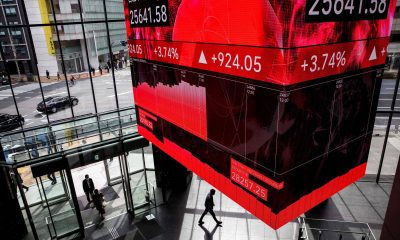Economy
House passes debt limit bill, Fed rate debate intensifies – what’s moving markets

The race to lift the U.S. debt ceiling before a disastrous default clears a major hurdle after the House of Representatives passes a bill raising the limit. Meanwhile, expectations that the Federal Reserve will skip hiking interest rates at its June meeting rise as debate swirls around the U.S. central bank’s future policy.
1. House passes debt ceiling bill; Senate up next
The debt ceiling drama in Washington may be inching toward a conclusion in the coming days after the U.S. House of Representatives voted in favor of a deal to raise the $31.4 trillion borrowing limit.
The bill, which would suspend the debt ceiling until 2025 and cap some government spending, is now one step closer to being enacted into law before a potentially catastrophic government default on June 5.
House Republicans and Democrats gave the green light to the agreement despite virulent objections from hard-line members on both the right and the left. The final vote tally of 314-117 on Wednesday was hailed as a “bipartisan compromise” by U.S. President Joe Biden and a win for House Speaker Kevin McCarthy.
The Senate now steps into the limelight, with the upper chamber’s majority leader Chuck Schumer saying he plans to bring the measure to the floor “as soon as possible.”
2. To pause or not to pause
Bets that the Federal Reserve will choose to push pause (albeit temporarily) on its long-standing interest rate tightening campaign grew following comments from two key officials on Wednesday, marking the latest twist in an ongoing debate over the U.S. central bank’s optimal policy path.
Fed Governor Philip Jefferson said in a speech on Wednesday that skipping a hike at the bank’s two-day meeting starting on June 13 would allow the rate-setting Federal Open Market Committee to “see more data” before making decisions about further increases to borrowing costs. As President Biden’s nominee for Fed vice chair, Jefferson is widely seen as a central figure in shaping future policy.
Meanwhile, Philadelphia Fed President Patrick Harker, a voting member of the FOMC, told a conference that “a bit of a skip” may be in order at the upcoming gathering.
The statements helped push the odds of a pause up to 63% from 37% a day earlier, according to Investing.com’s Fed Rate Monitor Tool.
Other Fed policymakers, however, have not shared these viewpoints, arguing that another rate rise may be needed to quell stubbornly elevated inflation.
3. Fresh jobs data
Fed officials still have some crucial data to review before they make their latest rate decision, including a fresh batch of job market data over the final two days of this week.
Later today, the ADP National Employment Report is expected to show that U.S. private employers hired 170,000 workers in May, down from 296,000 in the prior month.
The figure will likely provide a prologue to the much anticipated release of the Labor Department’s more comprehensive nonfarm payrolls report due out on Friday. Economists predict that the world’s biggest economy added 180,000 roles last month, slipping from 253,000 in April.
Policymakers have said they will be keeping a close eye on these readings to see if their over-year-long policy tightening cycle is cooling the labor market. In theory, this softening could contribute to a slowdown in price growth.
4. Futures rise after House vote
U.S. stock futures pointed higher, following the House’s passage of the debt ceiling bill.
By 05:00 ET (09:00 GMT), the benchmark S&P 500 futures contract added 9 points or 0.22%, Dow futures inched up 31 points or 0.09%, and Nasdaq 100 futures gained 11 points or 0.08%.
The main indices closed in the red on Wednesday as investors awaited the outcome of the House vote. Traders were also digesting economic data that showed a jump in job vacancies in April, which pointed to lingering strength in the U.S. labor market.
The number gave renewed life to predictions for a June rate increase by the Fed, although this move was later tempered by the comments from Jefferson and Harker (see above).
5. Oil edges higher in volatile trading
Oil prices reversed early losses in choppy trading on Thursday, as the House vote on the debt ceiling deal spurred predictions that the world’s biggest oil consumer would avoid a damaging default.
U.S. crude futures traded 0.21% higher at $68.23 per barrel, while the Brent contract climbed 0.28% to $72.80 a barrel.
The market had earlier dipped after data from the American Petroleum Institute showed an unexpected, large build in U.S. crude stocks last week, rising by around 5.2 million barrels, triggering fears of oversupply.
But these demand concerns were partially offset by a private sector survey showing that Chinese manufacturing activity grew by more than expected in May. The figures contrasted with government data released earlier this week and buoyed hopes of a recovery in top oil importer China.
Economy
Russian central bank says it needs months to make sure CPI falling before rate cuts -RBC


© Reuters. Russian Central Bank Governor Elvira Nabiullina attends a news conference in Moscow, Russia June 14, 2019. REUTERS/Shamil Zhumatov/File Photo
MOSCOW (Reuters) – Russia’s central bank will need two to three months to make sure that inflation is steadily declining before taking any decision on interest rate cuts, the bank’s governor Elvira Nabiullina told RBC media on Sunday.
The central bank raised its key interest rate by 100 basis points to 16% earlier in December, hiking for the fifth consecutive meeting in response to stubborn inflation, and suggested that its tightening cycle was nearly over.
Nabiullina said it was not yet clear when exactly the regulator would start cutting rates, however.
“We really need to make sure that inflation is steadily decreasing, that these are not one-off factors that can affect the rate of price growth in a particular month,” she said.
Nabiullina said the bank was taking into account a wide range of indicators but primarily those that “characterize the stability of inflation”.
“This will take two or three months or more – it depends on how much the wide range of indicators that characterize sustainable inflation declines,” she said.
The bank will next convene to set its benchmark rate on Feb. 16.
The governor also said the bank should have started monetary policy tightening earlier than in July, when it embarked on the rate-hiking cycle.
Economy
China identifies second set of projects in $140 billion spending plan


© Reuters. FILE PHOTO: Workers walk past an under-construction area with completed office towers in the background, in Shenzhen’s Qianhai new district, Guangdong province, China August 25, 2023. REUTERS/David Kirton/File Photo
SHANGHAI (Reuters) – China’s top planning body said on Saturday it had identified a second batch of public investment projects, including flood control and disaster relief programmes, under a bond issuance and investment plan announced in October to boost the economy.
With the latest tranche, China has now earmarked more than 800 billion yuan of its 1 trillion yuan ($140 billion) in additional government bond issuance in the fourth quarter, as it focuses on fiscal steps to shore up the flagging economy.
The National Development and Reform Commission (NDRC) said in a statement on Saturday it had identified 9,600 projects with planned investment of more than 560 billion yuan.
China’s economy, the world’s second largest, is struggling to regain its footing post-COVID-19 as policymakers grapple with tepid consumer demand, weak exports, falling foreign investment and a deepening real estate crisis.
The 1 trillion yuan in additional bond issuance will widen China’s 2023 budget deficit ratio to around 3.8 percent from 3 percent, the state-run Xinhua news agency has said.
“Construction of the projects will improve China’s flood control system, emergency response mechanism and disaster relief capabilities, and better protect people’s lives and property, so it is very significant,” the NDRC said.
The agency said it will coordinate with other government bodies to make sure that funds are allocated speedily for investment and that high standards of quality are maintained in project construction.
($1 = 7.1315 renminbi)
Economy
Russian central bank says it needs months to make sure CPI falling before rate cuts -RBC


© Reuters. Russian Central Bank Governor Elvira Nabiullina attends a news conference in Moscow, Russia June 14, 2019. REUTERS/Shamil Zhumatov/File Photo
MOSCOW (Reuters) – Russia’s central bank will need two to three months to make sure that inflation is steadily declining before taking any decision on interest rate cuts, the bank’s governor Elvira Nabiullina told RBC media on Sunday.
The central bank raised its key interest rate by 100 basis points to 16% earlier in December, hiking for the fifth consecutive meeting in response to stubborn inflation, and suggested that its tightening cycle was nearly over.
Nabiullina said it was not yet clear when exactly the regulator would start cutting rates, however.
“We really need to make sure that inflation is steadily decreasing, that these are not one-off factors that can affect the rate of price growth in a particular month,” she said.
Nabiullina said the bank was taking into account a wide range of indicators but primarily those that “characterize the stability of inflation”.
“This will take two or three months or more – it depends on how much the wide range of indicators that characterize sustainable inflation declines,” she said.
The bank will next convene to set its benchmark rate on Feb. 16.
The governor also said the bank should have started monetary policy tightening earlier than in July, when it embarked on the rate-hiking cycle.

 Forex2 years ago
Forex2 years agoForex Today: the dollar is gaining strength amid gloomy sentiment at the start of the Fed’s week

 Forex2 years ago
Forex2 years agoHow is the Australian dollar doing today?

 Forex1 year ago
Forex1 year agoUnbiased review of Pocket Option broker

 Forex2 years ago
Forex2 years agoDollar to pound sterling exchange rate today: Pound plummeted to its lowest since 1985

 Cryptocurrency2 years ago
Cryptocurrency2 years agoWhat happened in the crypto market – current events today

 World2 years ago
World2 years agoWhy are modern video games an art form?

 Stock Markets2 years ago
Stock Markets2 years agoMorgan Stanley: bear market rally to continue

 Economy2 years ago
Economy2 years agoCrude oil tankers double in price due to EU anti-Russian sanctions

































